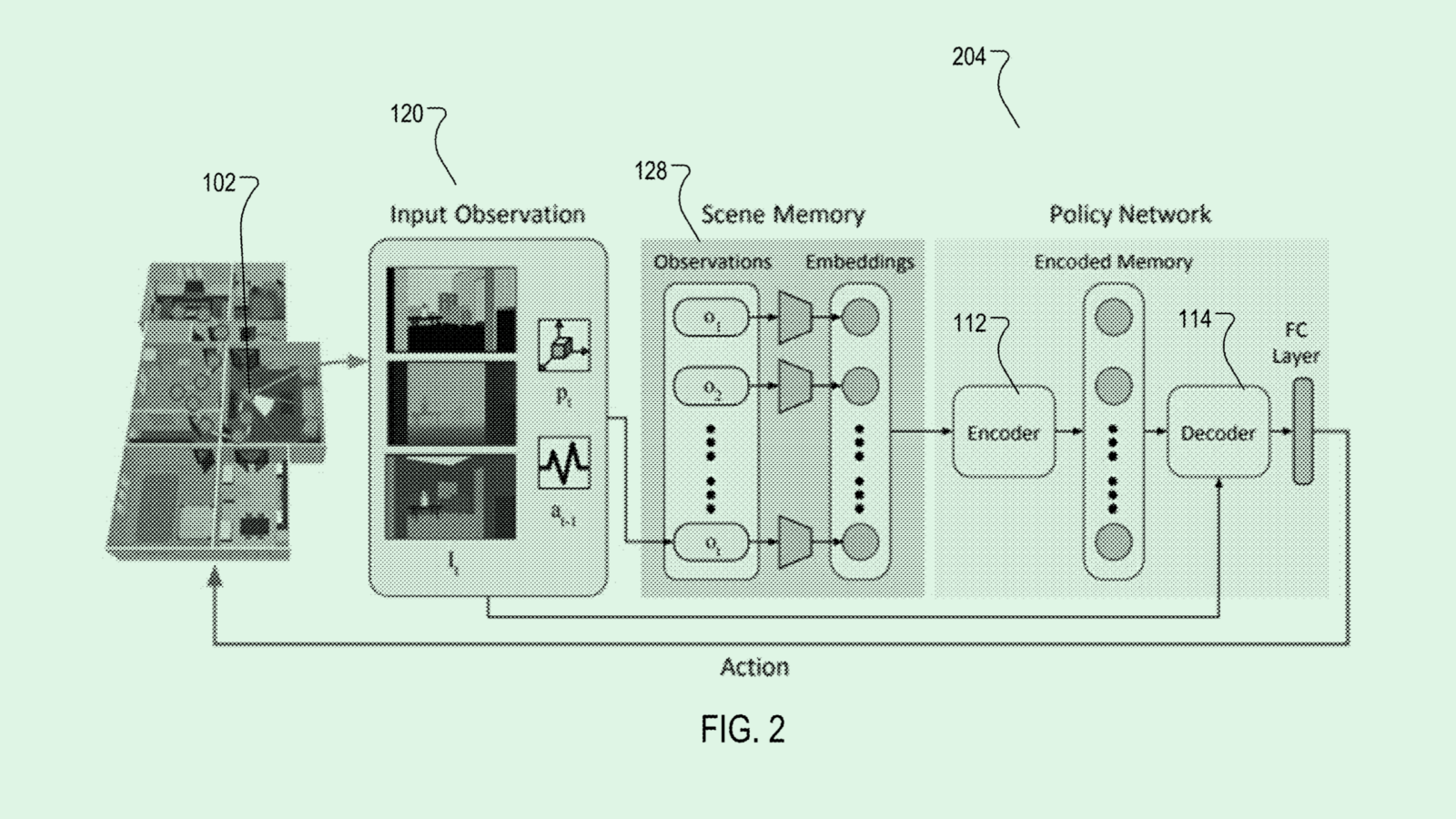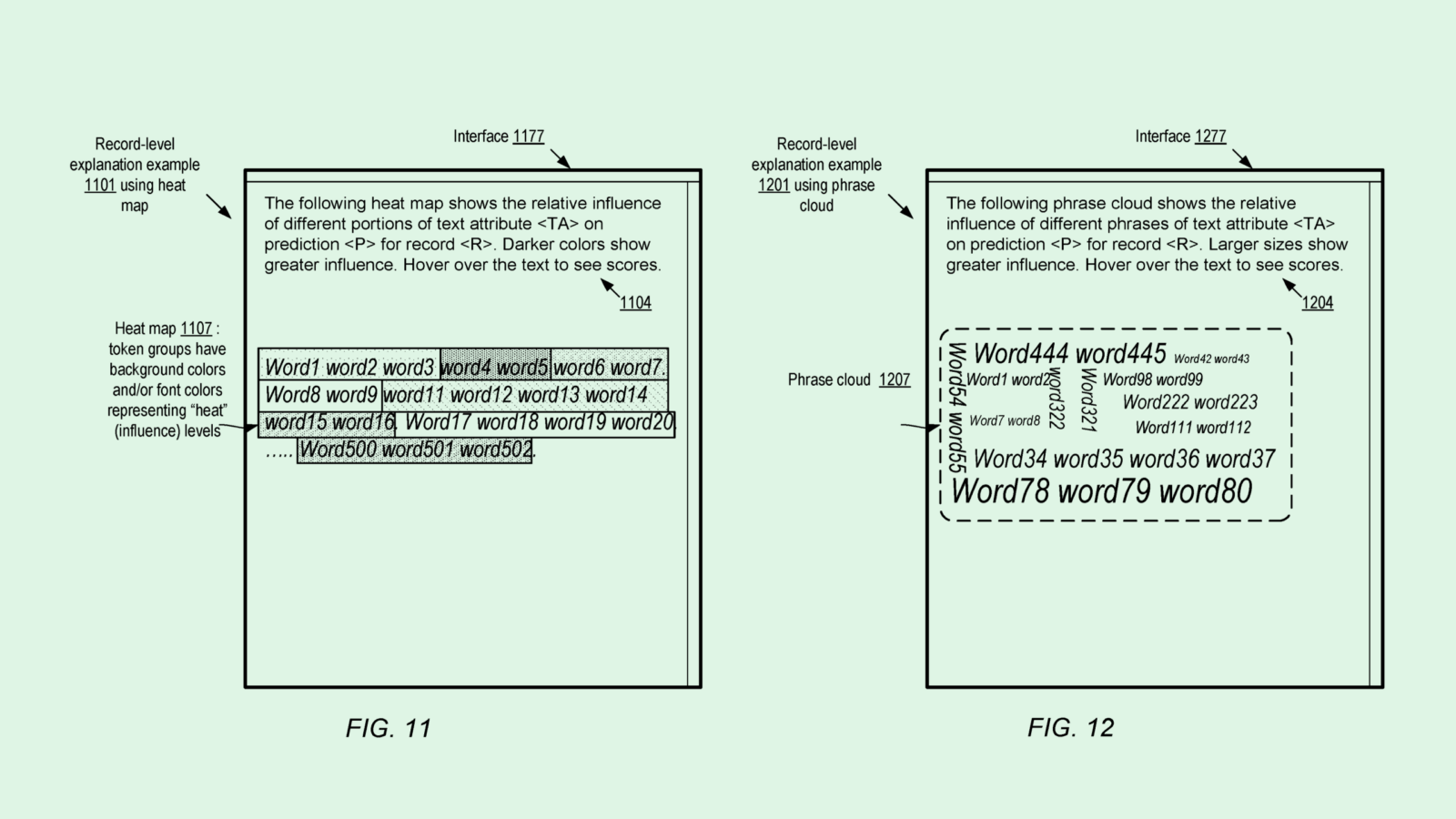Happy Thursday and welcome to Patent Drop!
Today, Google’s patent to give robots a long-term memory could signal the next frontier in AI-based robotics. Plus: Amazon wants to keep its AI models on a leash, and JPMorgan Chase may want to put blockchain to work.
Let’s jump in.
Google’s Long-Term Memory
Google wants to help robots strengthen their memories.
The company aims to patent a system that controls robotic agents “using scene memory data.” Google’s tech essentially helps robots have better decision-making skills by using neural networks to comprehend both historical data and the scenes in front of them.
“Many complex tasks … require the agent to perform tasks over a long time horizon,” Google said. “Hence, being able to properly capture past observations is crucial to achieving good performance on the task.”
To start, Google’s system would collect data about an environment through cameras or LIDAR sensors and convert them into embeddings, or structured data that a neural network can actually use. This information is added to a larger pot of “scene memory data,” or historical data with details on the environment’s dynamics.
Next, an encoder neural network with a “self-attention mechanism” takes in the scene memory and picks out relevant information from its past observations, creating an “encoded representation of the scene memory data.” Finally, that encoded representation is sent to a “decoder” neural network, which essentially creates an action plan for the robotic agent.
Google claims its tech allows these robots to “effectively capture long term dependencies and learn a relevant geometry of the environment,” as well as “prioritize particular observations at any given time step without requiring any pre-determined structure of the environment to be known in advance.”

Plenty of big tech firms have been hard at work researching ways to fuse AI and robotics to make these machines safer, more observant, and more reactive. Google DeepMind has also recently tested bringing Gemini’s capabilities to its robots, letting them handle natural language instructions and potentially fulfill tasks outside of simple navigation.
This patent could offer a novel way of helping autonomous machines learn and improve: long-term memory, said Rhonda Dibachi, CEO of manufacturing-as-a-service platform HeyScottie. “In order to be truly intelligent, you have to have both short-term — i.e., working — memory as well as long-term — i.e., situational — memory, and this is a way to do that,” Dibachi said.
Long-term memory allows autonomous machines the benefit of “situational intelligence,” said Dibachi. It’s the difference between a robot going into a space aware of the objects, dimensions, and people around it, and going in blind. “Rather than having to feed a robot all the information for the starting conditions … you can have a robot that remembers from yesterday.”
There is a lot of money to be made in making smarter robots, said Dibachi. Though these machines currently aren’t capable of hands-off operation, the potential productivity that autonomous logistics and production may hold is an attractive proposition to manufacturers and tech firms alike.
Though Google isn’t new to the world of robotics and autonomous machines, hardware is far from its main focus — it continues to plunge resources into software and large language model development. But tech like this could provide an avenue to access a valuable, vast well of real-world data, said Dibachi, whether it be from self-driving vehicles, factory robots, or humanoid co-workers.
Amazon Keeps AI in Check
Amazon wants to make sure AI models don’t fall out of line after they’re shipped out.
The company filed a patent application for “global explanations of machine learning model predictions.” The service would explain how deployed machine learning models come to their conclusions and monitor for behavioral shifts after the models are deployed.
Amazon noted its tech aims to cut down on bias, save on computing and memory resources, and increase “the transparency and explainability of decisions taken with the help of machine learning models … which can in turn lead to increasing confidence in machine learning algorithms in general.”
This service — which is incorporated “as part of a larger pipeline of machine learning tasks” within a cloud computing environment (a.k.a. AWS) — relies on a model trained specifically to generate predictions based on individual chunks of text by breaking them down by its different attributes.
For example, this system can provide analysis based on different phrases, sentences, paragraphs, or “tokens” — words or punctuation — of a body of AI-generated text. This analysis can help a user understand how an AI model came to its conclusions.
Additionally, these capabilities can monitor more than just individual outputs; they can also inspect how a model is performing after it’s put into practice. To do so, the system collects several explanatory predictions made during a certain time frame and determines whether or not they’ve deviated too far from certain baselines for fairness and accuracy. If they have, the system may recommend re-training the model to more accurately represent certain data or attributes.

Lots of patents in recent months have aimed to make AI more ethical and responsible, oftentimes taking on issues such as bias and accuracy in the training process. Conversely, this tech aims to monitor the operation of an AI model after it’s out in the wild, ensuring any bad habits not caught in training aren’t amplified.
But despite an influx of patents like these, the breakneck pace of development and innovation may be faster than that of any guardrails put in place, said Thomas Randall, advisory director at Info-Tech Research Group — especially after companies like Meta and OpenAI cut teams focused on risk and responsible AI. The pressure to keep up with the growing demand for more — from competitors, investors, and customers alike — could lead to safety precautions being sidelined, he added.
“I think the way in which organizations are adopting these kinds of models is actually not conducive to having a strategic overview of these responsible AI principles,” said Randall. “But if an organization doesn’t have responsible AI peace of mind, especially around fairness and bias, you’re going to end up with a bad outcome.”
However, by embedding tools for observability and explainability into its vast array of service offerings, Amazon could help developers using AWS build more and worry less. The company’s cloud services offerings already lead in market share, with its sales only inflated by the AI boom. Staking a claim in responsible AI IP certainly couldn’t hurt.
“Further research into explainability and observability technologies could enhance AWS’ lead, allowing Amazon to host a diverse array of third-party models while also providing users with predictable outcomes across different models — an offering unique among big tech players,” said Ido Caspi, research analyst at Global X ETFs.
JPMorgan Chase’s Data Tracker
JPMorgan Chase may be looking to take advantage of blockchain’s good qualities.
The financial institution filed a patent application for “tracking data lineage and record lifecycle using distributed ledgers.” As its title implies, this tech uses the traceability and immutability of blockchain to verify the integrity of digital records.
JPMorgan noted in its application that tracing the movements of data requires “a considerable amount of manual effort,” but is “necessary to meet various regulatory requirements and to understand the impact of legislation,” such as the EU GDPR and California’s Consumer Privacy Act.
Any time a “record lifecycle event” occurs — such as the creation, modification, or deletion of a digital record — this tool creates a “recordable artifact,” as well as metadata describing the data itself. The metadata is then digitally signed by this system, verifying its authenticity. Along with this, a “hash” of the data is created, giving it a unique digital fingerprint.
The artifact, hash, and metadata are stored in a “verifiable and immutable” database using distributed ledger or blockchain technology. If a user needs to access a certain digital record, a new hash is generated for the record’s current state, and the system provides a digital trail of all relevant storage locations and metadata.
The point is to make data and record-keeping transparent, using blockchain to “provide a trusted audit of data flows.”

This patent isn’t the financial institution’s first rodeo with blockchain. The company launched Onyx, which it called the first “bank-led blockchain platform for the exchange of value, information and digital assets,” in 2020 following the launch of its own digital currency, JPM Coin. Onyx offers an ecosystem of blockchain-based enterprise tech, including digital infrastructure for asset and data exchanges, programmable payments, and even space-based blockchain transactions.
And despite CEO Jamie Dimon’s distaste for Bitcoin — which he called “the pet rock” in an interview earlier this year — he told CNBC that “blockchain is real. It’s a technology. We use it. It’s going to move money, it’s going to move data. It’s efficient.”
JPMorgan isn’t the only firm that sees blockchain’s potential blockchain. Companies across many industries have been researching ways to put blockchain to good use, including avoiding fraud, tracking down deepfakes, personal record-keeping, or even keeping track of road salting.
That’s because blockchain’s biggest assets — transparency and immutability — are applicable to numerous industries. Using it for a strong record-keeping and data-tracking system can be helpful in any business that passes lots of confidential data back and forth.
Extra Drops
- Ford wants your car to follow your gaze. The company is seeking to patent “adaptively steered vehicle headlamps” that change direction depending on where you look.
- eBay wants to know what you’re promoting. The company filed a patent application for “social network-based inventory management.”
- JPMorgan Chase wants to find your company’s weak points. The company is seeking to patent “vulnerability scoring based on organization-specific metrics.”
What Else is New?
- OpenAI is launching a new smaller model, called GPT-4o mini. The company claims the model is “the most capable and cost-efficient small model available today.”
- Meta is reportedly in talks to acquire a stake in EssilorLuxotica, its partner in making Ray-Ban smart glasses.
- What Connects Artificial Intelligence, The 2024 US Presidential Election, and Silicon Valley? Find out in Semafor Technology — a twice-weekly twice weekly newsletter that examines the people, the money, and the ideas at the center of the new era of Tech. Join 50,000 technology leaders who rely on Semafor’s insights — subscribe for free today.*
* Partner
Patent Drop is written by Nat Rubio-Licht. You can find them on Twitter @natrubio__.
Patent Drop is a publication of The Daily Upside. For any questions or comments, feel free to contact us at patentdrop@thedailyupside.com.
